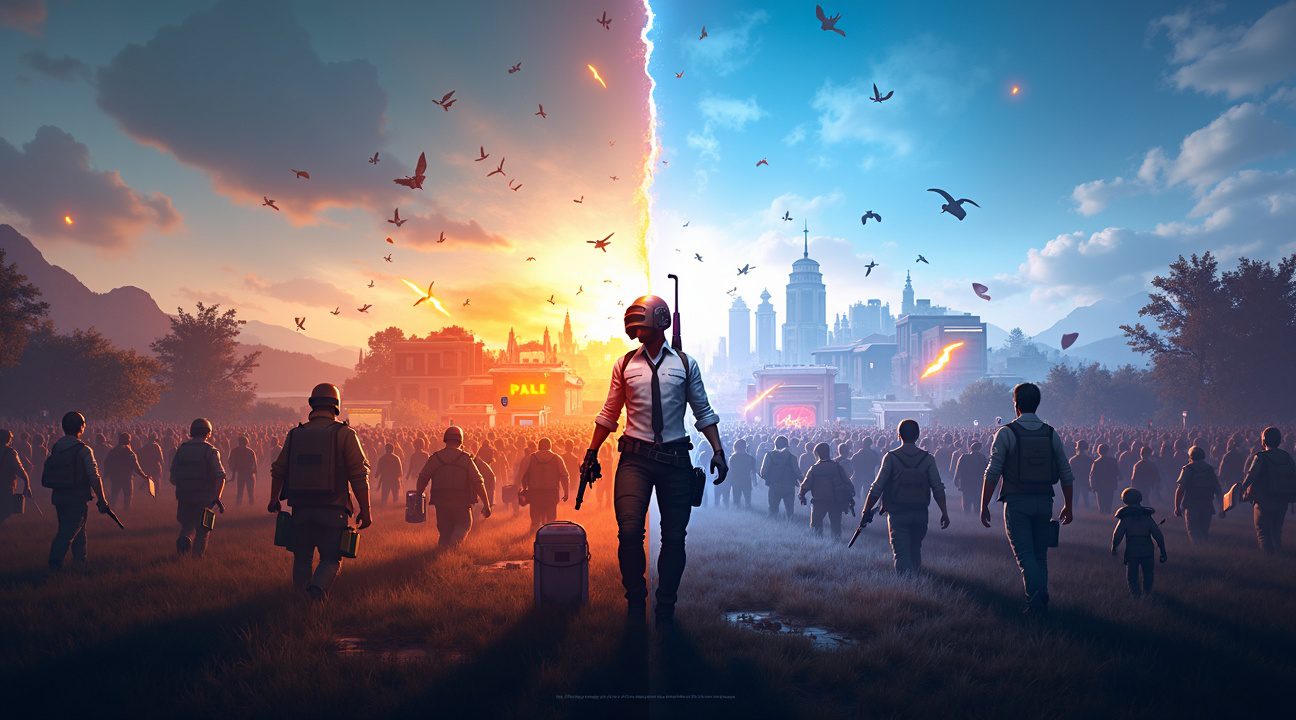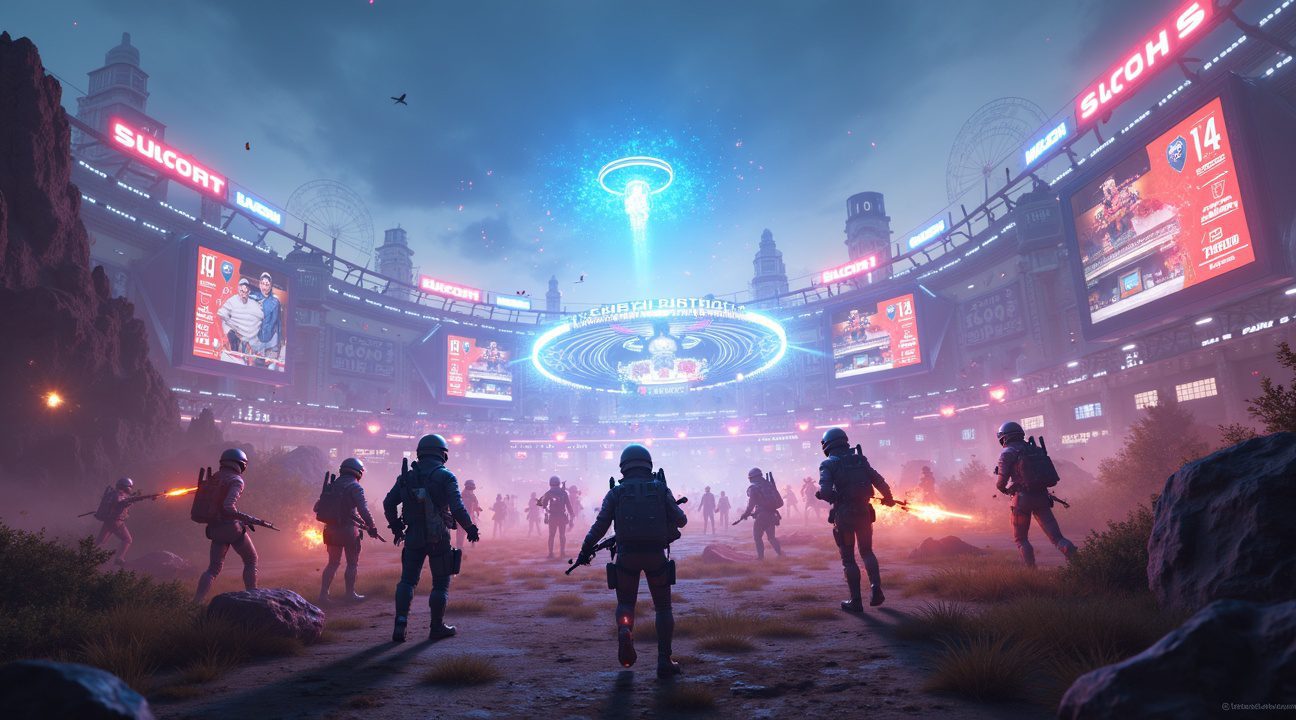PUBG has defied industry expectations eight years after launch, achieving remarkable player milestones including over 700,000 peak concurrent players and maintaining consistent daily engagement between 400,000-600,000 players across PC and console platforms.
Enduring Success of PUBG
Since its release, PUBG has continually evolved to meet the dynamic demands of the gaming community. Its transition to a free-to-play model in January 2022 rejuvenated the player base and strategically positioned the game amidst newer battle royale entrants.
Key Takeaways
- PUBG reached a daily peak of 702,796 concurrent players in July 2025, marking one of its most successful performance metrics in several years.
- The free-to-play transition in January 2022 resulted in a 57% surge in average player count, sustaining higher engagement rates that surpass those observed before the shift.
- PUBG Mobile boasts 112.9 million monthly active users and a staggering 1.27 billion total registered players, while its PC and console versions maintain over 80 million registered users.
- Growth dynamics differ by region, with Asian markets favoring mobile platforms, while Western audiences continue to drive robust participation on PC.
- Krafton’s 2025 roadmap includes regular content drops, increased community engagement initiatives, and enhanced esports infrastructure to stay competitive in the battle royale arena.
PUBG’s sustained relevance in a saturated gaming market is further strengthened by its adaptability, global reach, and ongoing commitment to innovation in both gameplay experiences and community offerings. With consistent updates and an active player base, the franchise demonstrates how legacy titles can evolve and thrive over time.
PUBG’s Impressive Player Surge: 700,000+ Peak Players Despite Being 8 Years Old
PUBG continues to defy expectations eight years after its initial release, demonstrating remarkable staying power in the competitive battle royale market. The numbers speak volumes about the game’s enduring appeal and the success of its free-to-play transition.
PC and console platforms achieved a stunning milestone in July 2025 when PUBG reached a daily peak of 702,796 players on July 23rd. This surge represents one of the highest concurrent player counts the game has seen in recent memory. Daily concurrent player numbers consistently hover between 400,000 and 600,000, indicating a healthy and engaged player base that remains actively invested in the experience.
The mobile version tells an even more impressive story of sustained growth and global reach. PUBG Mobile recorded 112.9 million monthly active users in June 2025, building on the momentum from its peak of 125.3 million monthly active users in February 2024. These figures showcase the mobile platform’s incredible penetration into markets worldwide and its ability to maintain massive user engagement.
Registration numbers paint a picture of PUBG’s expansive reach across the gaming community. Total registered users exceed 80 million for the core PUBG experience across PC and console platforms. PUBG Mobile has achieved an astronomical 1.27 billion registered users, cementing its position as one of the most downloaded and played mobile games in history.
Understanding Player Metrics and Daily Engagement
Google Trends data provides additional insight into PUBG Mobile’s daily performance patterns. Daily player numbers fluctuated between 53,600 and 62,600 throughout July 2025, reflecting consistent engagement patterns that developers can rely on for planning updates and events.
Understanding different player metrics helps contextualize these impressive numbers:
- Concurrent players represent the number of users actively playing at the exact same moment
- Monthly active users (MAU) count unique individuals who accessed the game at least once within a 30-day period
- Registration numbers indicate total accounts created since launch
- Daily peaks show the highest simultaneous player count achieved within a 24-hour window
The distinction between these metrics matters significantly when evaluating a game’s health and trajectory. While concurrent players demonstrate real-time engagement and server load requirements, monthly active users better reflect the game’s overall reach and retention capabilities. PUBG’s strength across both metrics indicates a title that not only attracts new players but keeps them coming back regularly.
These player surge numbers become even more remarkable when considering the broader gaming landscape. Many titles struggle to maintain relevance beyond their first few years, yet PUBG has managed to reinvent itself and attract both long-time fans and newcomers. The free-to-play model has clearly opened doors for players who might have been hesitant to purchase the game initially.
PUBG’s performance stands in stark contrast to titles that have struggled with player retention and longevity. Unlike games that close due to persistent issues, PUBG has addressed many of its early challenges and emerged stronger. The developer’s commitment to regular updates, new content, and platform optimization has paid dividends in maintaining this impressive player base.
The sustained success across both traditional and mobile platforms demonstrates PUBG’s ability to adapt to different gaming preferences and technological capabilities. While PC and console versions offer the full tactical experience that hardcore fans appreciate, the mobile version brings accessibility and convenience that appeals to casual gamers and those in markets where mobile gaming dominates.
These player numbers represent more than just statistics—they reflect a community that continues to find value in PUBG’s unique blend of tactical gameplay, strategic depth, and competitive excitement. The game’s ability to maintain such strong concurrent player counts and monthly active user numbers eight years post-launch positions it as a lasting fixture in the battle royale genre.
How Free-to-Play Revitalized PUBG’s Fortunes in 2022 and Beyond
PUBG Battlegrounds’ decision to embrace a free-to-play model in January 2022 proved to be a strategic masterstroke that breathed new life into the battle royale giant. Within just one month of dropping its price tag, the game experienced an impressive 57% surge in its average player count, catapulting from 153,000 to 242,000 concurrent players.
Sustained Growth Defies Industry Trends
This initial spike wasn’t just a temporary honeymoon period. I’ve observed how PUBG’s player base has maintained consistent growth patterns, staying well above pre-free-to-play numbers throughout its transformation. By June 2025, the concurrent player statistics showed continued upward momentum, surpassing both 2024 and 2023 benchmarks.
The sustained success demonstrates how removing financial barriers can reinvigorate even mature gaming titles. PUBG’s approach contrasts sharply with many other battle royale games that have struggled to maintain relevance. While some free-to-play shooters have faced closure due to various challenges, PUBG’s established foundation and refined gameplay mechanics provided a solid base for this transition.
Attracting Diverse Player Demographics
The free-to-play model particularly resonated with two key groups:
- Returning veterans who had stepped away from the game found renewed interest without additional financial commitment.
- Newcomers who had previously hesitated due to cost barriers finally took the plunge.
Rising AAA game prices have made free-to-play alternatives increasingly attractive. As premium titles continue climbing past traditional $60 price points, reaching $70 or higher, PUBG’s zero-entry-cost approach offers compelling value. Players can experience hundreds of hours of content without upfront investment, making their purchasing decisions based on enjoyment rather than speculation.
The transition also allowed PUBG to compete more effectively with established free-to-play competitors like Fortnite and Apex Legends. Rather than asking players to choose between paid and free options, PUBG eliminated that decision entirely, focusing competition purely on gameplay quality and content delivery.
PUBG’s revenue model shifted to rely on:
- Battle passes
- Cosmetic purchases
- Premium subscriptions
This approach has proven sustainable while maintaining the core gameplay experience that made PUBG a phenomenon. The consistent player growth suggests that this monetization strategy successfully balances profitability with player satisfaction, creating a foundation for continued success in an increasingly competitive market.

PUBG’s Revenue Powerhouse: Millions Monthly Despite Free Entry
PUBG Mobile continues to demonstrate that free-to-play models can generate extraordinary revenue streams when executed properly. The game consistently earns millions monthly through carefully designed monetization systems that enhance rather than hinder the gameplay experience.
Virtual Economy Drives Financial Success
The PUBG Mobile UC Market serves as the foundation of PUBG’s financial ecosystem. This virtual currency system allows players to purchase premium content without feeling pressured into mandatory transactions. UC bundles remain consistently popular, offering players flexible spending options that range from small purchases to larger investments. I’ve observed that this approach creates a sustainable revenue model by catering to different spending preferences across the global player base.
Season passes represent another significant revenue driver, providing players with exclusive rewards and progression systems. These time-limited offerings create urgency while delivering substantial value through cosmetic items, character upgrades, and unique gameplay features. The success of this model lies in its ability to generate recurring revenue without affecting core gameplay balance.
Skins and cosmetic items form the backbone of PUBG’s monetization strategy. Players consistently invest in weapon skins, character outfits, and vehicle customizations that allow personal expression within the game. These purchases don’t impact competitive balance, ensuring that free players can compete on equal footing with paying customers.
Competitive Positioning Against Industry Giants
PUBG maintains significant market share despite intense competition from established titles like Warzone and Apex Legends. The game’s distinctive realistic gameplay mechanics and tactical approach appeal to players seeking authentic battle royale experiences. This positioning differentiates PUBG from more arcade-style competitors and attracts dedicated communities who value strategic gameplay.
The international user base provides sustainable revenue diversity across multiple markets. Unlike some competitors that face challenges with cheating issues affecting player retention, PUBG’s established infrastructure and continuous updates help maintain player engagement. This stability translates directly into consistent revenue streams as engaged players are more likely to invest in premium content.
PUBG’s success demonstrates that transitioning to free-to-play doesn’t diminish revenue potential when supported by smart monetization strategies. The combination of virtual currency systems, cosmetic purchases, and seasonal content creates multiple touchpoints for player investment while preserving the competitive integrity that defines the battle royale genre.
Krafton’s 2025 Roadmap Keeps Players Engaged with Fresh Content
Krafton’s March 2025 roadmap announcement demonstrates the developer’s commitment to maintaining PUBG’s relevance in the competitive battle royale market. This comprehensive plan outlines regular content updates, ongoing game support, and community-focused events that directly address player retention challenges.
The roadmap’s implementation has already produced measurable results. Player numbers experience notable surges during event periods and major update launches. These temporary spikes indicate that fresh content remains a powerful tool for re-engaging both active and dormant players. The anticipation surrounding rumored developments like PUBG 2.0 creates additional momentum within the community.
Community-Driven Engagement Strategies
Several key components drive PUBG’s enhanced community engagement under the 2025 roadmap:
- Streamer partnerships that amplify content visibility across major platforms
- Competitive esports tournaments featuring substantial prize pools
- Direct feedback channels allowing players to influence development priorities
- Seasonal content drops that introduce limited-time modes and cosmetics
- Community challenges that reward collective player participation
Seasonal content particularly stands out as an engagement driver. Each new season brings fresh gameplay mechanics, weapon additions, map modifications, and cosmetic options that give players compelling reasons to return. These updates create predictable excitement cycles that help maintain steady player interest between major releases.
Krafton’s strategy extends beyond simple content additions. The developer actively monitors cheating concerns and technical issues that could undermine player experience. This proactive approach helps preserve the game’s competitive integrity while fostering trust within the community.
The roadmap’s success lies in its balance between innovation and stability. Players appreciate knowing what to expect while still receiving surprises through unannounced features and events. This predictable unpredictability keeps the community engaged without creating unrealistic expectations.
Esports integration represents another crucial element of the roadmap. Professional tournaments provide aspirational content for casual players while generating substantial viewership numbers. These events showcase PUBG’s competitive potential and often introduce new viewers to the game.
Direct player feedback channels have transformed how Krafton approaches development decisions. Community suggestions frequently influence weapon balancing, map design changes, and quality-of-life improvements. This collaborative approach makes players feel invested in the game’s evolution rather than simply consuming predetermined content.
The 2025 roadmap’s early success suggests that consistent, quality updates can effectively counteract the natural player decline that affects most free-to-play titles. By maintaining this momentum, PUBG positions itself to remain competitive against newer battle royale entries while satisfying its existing player base’s evolving preferences.

Asia Drives Mobile Growth While West Sustains PC Gaming
PUBG’s global footprint reveals striking regional patterns that define how different markets embrace the battle royale phenomenon. I’ve observed that mobile gaming’s explosive growth in Asia contrasts sharply with the sustained PC gaming preferences in Western territories, creating distinct ecosystems within the same franchise.
Mobile Gaming Dominance Across Asian Markets
PUBG Mobile commands an impressive presence throughout Asia, where smartphone accessibility and affordability have transformed gaming habits. Countries like India, Southeast Asia, and China represent the backbone of mobile gaming adoption, with millions of players choosing touchscreen controls over traditional gaming setups.
This regional preference stems from practical considerations that shape entertainment choices across these markets:
- Smartphones cost significantly less than gaming PCs or consoles, making mobile gaming more accessible to broader demographics
- Internet infrastructure in many Asian countries supports mobile connectivity better than home broadband required for PC gaming
- Cultural acceptance of mobile gaming as a primary entertainment platform eliminates stigma often associated with casual gaming
- Commuter-heavy lifestyles in major Asian cities favor portable gaming experiences that fit into daily routines
Economic factors play a crucial role in this mobile-first approach. I’ve noticed that many Asian markets prioritize value and convenience, making a single device that handles communication, work, and gaming particularly appealing to cost-conscious consumers.
Western Markets Maintain Traditional Gaming Preferences
Meanwhile, PUBG’s PC and console versions continue attracting dedicated player bases across Europe, North America, and parts of South America. These regions demonstrate loyalty to traditional gaming platforms despite mobile gaming’s global surge.
Western gaming culture values precision controls, high-resolution displays, and competitive integrity that PC gaming delivers. Players in these markets often invest heavily in gaming hardware, viewing it as a long-term entertainment investment rather than seeking the immediate accessibility that mobile gaming provides.
However, I must acknowledge that growth rates in these Western territories don’t match the explosive expansion seen in mobile-driven regions. This disparity doesn’t indicate declining interest but rather reflects market maturity and established gaming preferences that resist rapid shifts.
The free-to-play transition has helped PUBG maintain relevance in competitive Western markets where numerous shooting games compete for player attention. Removing financial barriers allows more players to experience the core gameplay while generating revenue through cosmetic purchases and battle passes.
Cultural factors significantly influence these regional distinctions. Western gaming communities often emphasize competitive integrity and technical performance, areas where PC gaming traditionally excels. Asian markets, conversely, frequently prioritize social features and accessibility, strengths that mobile platforms naturally provide.
Platform preferences also reflect broader technological adoption patterns. Western households typically maintain multiple gaming devices, allowing family members to choose their preferred platform. Asian markets often center around shared mobile devices or individual smartphones that serve multiple purposes beyond gaming.
PUBG’s publishers have adapted their strategies to accommodate these regional differences. Mobile versions receive frequent updates tailored to Asian preferences, including collaborative events with popular local brands and features that enhance social interaction. PC versions focus on competitive balance and technical improvements that satisfy Western gaming standards.
These geographic divides highlight how economic conditions, cultural values, and technological infrastructure shape gaming preferences worldwide. I believe PUBG’s ability to succeed across both mobile and traditional platforms demonstrates the franchise’s adaptability to diverse market conditions rather than indicating platform superiority.
The sustained success in both regions proves that different gaming approaches can coexist profitably. Asia’s mobile growth provides user volume and engagement metrics, while Western PC gaming delivers dedicated communities willing to invest in premium content and long-term gameplay experiences.

Why PUBG Remains Competitive After 8 Years in a Crowded Market
PUBG’s longevity in the crowded battle royale space comes down to three fundamental strengths that newer competitors often struggle to replicate. The game’s tactical realism sets it apart from more arcade-style alternatives, demanding strategic positioning, resource management, and calculated decision-making that appeals to players who crave authentic combat experiences.
Core Gameplay Elements That Maintain Player Loyalty
The depth of PUBG’s mechanics continues to attract both newcomers and veterans who appreciate its unforgiving nature. Unlike many competitors that prioritize flashy abilities or simplified mechanics, PUBG rewards patience, map knowledge, and precise gunplay. This creates a skill ceiling that keeps dedicated players engaged for thousands of hours, as mastery requires genuine tactical understanding rather than memorizing ability rotations.
Frequent content updates have become another cornerstone of PUBG’s sustained success. The developers consistently introduce:
- New maps
- Weapons
- Game modes
- Seasonal events
These updates prevent the experience from becoming stale. Many of these enhancements incorporate community feedback, showing that the development team actively listens to player concerns and suggestions.
Community Strength and Developer Responsiveness
PUBG’s global community remains remarkably active and passionate, with players from diverse regions contributing to its consistent player count. This international appeal helps maintain healthy matchmaking queues across different time zones and skill levels. The game’s esports presence further strengthens community engagement, with regular tournaments and competitive leagues that showcase high-level play.
The transition to free-to-play has opened doors for new players who might have been hesitant to purchase the game initially. This move proved particularly strategic as it coincided with increased competition from other free battle royale titles. By removing the price barrier while maintaining its core identity, PUBG successfully expanded its potential player base without alienating existing fans.
Developer engagement plays a crucial role in PUBG’s continued relevance. Regular communication through:
- Social media
- Community forums
- Developer blogs
…keeps players informed about upcoming changes and demonstrates ongoing commitment to the game’s evolution. This transparency builds trust and shows that PUBG isn’t just another cash grab, but a continuously supported gaming experience.
Even as other shooting games face closure due to various challenges, PUBG’s combination of tactical depth, responsive development, and strong community foundation continues to differentiate it from competitors. The game’s ability to balance innovation with its core identity has created a sustainable model that few battle royale titles have managed to achieve over such an extended period.
Sources:
ActivePlayer.io, “PUBG MOBILE Live Player Count & Statistics (2025)”
Udonis Blog, “PUBG Mobile Player Count, Revenue & Stats [2025]”
ExitLag, “PUBG Player Count in 2025: Latest Numbers and Trends”
PlayerAuctions, “PUBG Live Player Count & Population 2025” & “PUBG Mobile Live Player Count & Population 2025”
Esports Insider, “Is PUBG getting more popular? Why you should play it in 2025”
Business of Apps, “PUBG Mobile Revenue and Usage Statistics”

